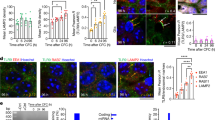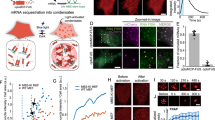Abstract
The cytoskeleton controls the architecture and survival of central nervous system (CNS) neurons by maintaining the stability of axons and dendrites. Although neurofilaments (NFs) constitute the main cytoskeletal network in these structures, the mechanism that underlies subunit incorporation into filaments remains a mystery. Here we report that NUDEL, a mammalian homologue of the Aspergillus nidulans nuclear distribution molecule NudE, is important for NF assembly, transport and neuronal integrity. NUDEL facilitates the polymerization of NFs through a direct interaction with the NF light subunit (NF-L). Knockdown of NUDEL by RNA interference (RNAi) in a neuroblastoma cell line, primary cortical neurons or post-natal mouse brain destabilizes NF-L and alters the homeostasis of NFs. This results in NF abnormalities and morphological changes reminiscent of neurodegeneration. Furthermore, variations in levels of NUDEL correlate with disease progression and NF defects in a mouse model of neurodegeneration. Thus, NUDEL contributes to the integrity of CNS neurons by regulating NF assembly.
This is a preview of subscription content, access via your institution
Access options
Subscribe to this journal
Receive 12 print issues and online access
$209.00 per year
only $17.42 per issue
Buy this article
- Purchase on Springer Link
- Instant access to full article PDF
Prices may be subject to local taxes which are calculated during checkout








Similar content being viewed by others
References
Morris, J.A., Kandpal, G., Ma, L. & Austin, C.P. DISC1 (disrupted in schizophrenia 1) is a centrosome-associated protein that interacts with MAP1A, MIPT3, ATF4/5 and NUDEL: regulation and loss of interaction with mutation. Hum. Mol. Genet. 12, 1591–608 (2003).
Niethammer, M. et al. NUDEL is a novel Cdk5 substrate that associates with LIS1 and cytoplasmic dynein. Neuron 28, 697–711 (2000).
Sasaki, S. et al. A LIS1/NUDEL/cytoplasmic dynein heavy chain complex in the developing and adult nervous system. Neuron 28, 681–696 (2000).
Smith, D.S. et al. Regulation of cytoplasmic dynein behaviour and microtubule organization by mammalian Lis1. Nature Cell Biol. 2, 767–775 (2000).
Toyo-oka, K. et al. 14–3-3ε is important for neuronal migration by binding to NUDEL: a molecular explanation for Miller-Dieker syndrome. Nature Genet. 34, 274–285 (2003).
Fuchs, E. & Cleveland, D.W. A structural scaffolding of intermediate filaments in health and disease. Science 279, 514–519 (1998).
Julien, J.P. Neurofilament functions in health and disease. Curr. Opin. Neurobiol. 9, 554–560 (1999).
Julien, J.P. & Mushynski, W.E. Neurofilaments in health and disease. Prog. Nucleic Acid Res. Mol. Biol. 61, 1–23 (1998).
Lariviere, R.C. & Julien, J.P. Functions of intermediate filaments in neuronal development and disease. J. Neurobiol. 58, 131–48 (2004).
Lee, M.K. & Cleveland, D.W. Neuronal intermediate filaments. Annu. Rev. Neurosci. 19, 187–217 (1996).
Kost, S.A., Chacko, K. & Oblinger, M.M. Developmental patterns of intermediate filament gene expression in the normal hamster brain. Brain Res. 595, 270–280 (1992).
Schlaepfer, W.W. & Bruce, J. Simultaneous up-regulation of neurofilament proteins during the postnatal development of the rat nervous system. J. Neurosci. Res. 25, 39–49 (1990).
Zhu, Q., Couillard-Despres, S. & Julien, J.P. Delayed maturation of regenerating myelinated axons in mice lacking neurofilaments. Exp. Neurol. 148, 299–316 (1997).
Bennett, G.S. & DiLullo, C. Slow post-translational modification of a neurofilament protein. J. Cell Biol. 100, 1799–1804 (1985).
Black, M.M., Keyser, P. & Sobel, E. Interval between the synthesis and assembly of cytoskeletal proteins in cultured neurons. J. Neurosci. 6, 1004–1012 (1986).
Rao, M.V. et al. Myosin Va binding to neurofilaments is essential for correct myosin Va distribution and transport and neurofilament density. J. Cell Biol. 159, 279–290 (2002).
Roy, S. et al. Neurofilaments are transported rapidly but intermittently in axons: implications for slow axonal transport. J. Neurosci. 20, 6849–6861 (2000).
Shah, J.V., Flanagan, L.A., Janmey, P.A. & Leterrier, J.F. Bidirectional translocation of neurofilaments along microtubules mediated in part by dynein/dynactin. Mol. Biol. Cell 11, 3495–3508 (2000).
Wang, L., Ho, C.L., Sun, D., Liem, R.K. & Brown, A. Rapid movement of axonal neurofilaments interrupted by prolonged pauses. Nature Cell Biol. 2, 137–141 (2000).
Yabe, J.T., Pimenta, A. & Shea, T.B. Kinesin-mediated transport of neurofilament protein oligomers in growing axons. J. Cell Sci. 112, 3799–3814 (1999).
Helfand, B.T., Chang, L. & Goldman, R.D. The dynamic and motile properties of intermediate filaments. Annu. Rev. Cell Dev. Biol. 19, 445–467 (2003).
Helfand, B.T., Chang, L. & Goldman, R.D. Intermediate filaments are dynamic and motile elements of cellular architecture. J. Cell Sci. 117, 133–141 (2004).
Jung, C., Yabe, J., Wang, F.S. & Shea, T.B. Neurofilament subunits can undergo axonal transport without incorporation into Triton-insoluble structures. Cell. Motil. Cytoskeleton 40, 44–58 (1998).
Julien, J.P. & Mushynski, W.E. The distribution of phosphorylation sites among identified proteolytic fragments of mammalian neurofilaments. J. Biol. Chem. 258, 4019–4025 (1983).
Beaulieu, J.M., Jacomy, H. & Julien, J.P. Formation of intermediate filament protein aggregates with disparate effects in two transgenic mouse models lacking the neurofilament light subunit. J. Neurosci. 20, 5321–5328 (2000).
Beaulieu, J.M., Robertson, J. & Julien, J.P. Interactions between peripherin and neurofilaments in cultured cells: disruption of peripherin assembly by the NF-M and NF-H subunits. Biochem. Cell Biol. 77, 41–45 (1999).
Lee, M.K., Xu, Z., Wong, P.C. & Cleveland, D.W. Neurofilaments are obligate heteropolymers in vivo. J. Cell Biol. 122, 1337–1250 (1993).
Fujita, Y., Okamoto, K., Sakurai, A., Gonatas, N.K. & Hirano, A. Fragmentation of the Golgi apparatus of the anterior horn cells in patients with familial amyotrophic lateral sclerosis with SOD1 mutations and posterior column involvement. J. Neurol. Sci. 174, 137–140 (2000).
Helfand, B.T., Mendez, M.G., Pugh, J., Delsert, C. & Goldman, R.D. A role for intermediate filaments in determining and maintaining the shape of nerve cells. Mol. Biol. Cell 14, 5069–5081 (2003).
Xie, Z., Sanada, K., Samuels, B.A., Shih, H. & Tsai, L.H. Serine-732 phosphorylation of FAK by Cdk5 is important for microtubule organization, nuclear movement, and neuronal migration. Cell 114, 469–482 (2003).
Julien, J.P. Amyotrophic lateral sclerosis: unfolding the toxicity of the misfolded. Cell 104, 581–591 (2001).
Nguyen, M.D., Lariviere, R.C. & Julien, J.P. Deregulation of Cdk5 in a mouse model of ALS: toxicity alleviated by perikaryal neurofilament inclusions. Neuron 30, 135–147 (2001).
Couillard-Despres, S. et al. Protective effect of neurofilament-heavy-gene overexpression in motor neuron disease induced by mutant superoxide dismutase. Proc. Natl Acad. Sci. USA 95, 9626–9630 (1998).
Hirokawa, N., Glicksman, M.A. & Willard, M.B. Organization of mammalian neurofilament polypeptides within the neuronal cytoskeleton. J. Cell Biol. 98, 1523–1536 (1984).
Hisanaga, S. & Hirokawa, N. Structure of the peripheral domains of neurofilaments revealed by low angle rotary shadowing. J. Mol. Biol. 202, 297–305 (1988).
Yuan, A., Rao, M.V., Kumar, A., Julien, J.P. & Nixon, R.A. Neurofilament transport in vivo minimally requires hetero-oligomer formation. J. Neurosci. 23, 9452–9458 (2003).
Carpenter, S. Proximal axonal enlargement in motor neuron disease. Neurology 18, 841–851 (1968).
Rouleau, G.A. et al. SOD1 mutation is associated with accumulation of neurofilaments in amyotrophic lateral sclerosis. Ann. Neurol. 39, 128–131 (1996).
Schmidt, M.L. et al. Epitope map of neurofilament protein domains in cortical and peripheral nervous system Lewy bodies. Am. J. Pathol. 139, 53–65 (1991).
Bergeron, C. et al. Neurofilament-light and polyadenylated mRNA levels are decreased in amyotrophic lateral sclerosis motor neurons. J. Neuropathol. Exp. Neurol. 53, 221–230 (1994).
Hill, W.D., Arai, M., Cohen, J.A. & Trojanowski, J.Q. Neurofilament mRNA is reduced in Parkinson's disease substantia nigra pars compacta neurons. J. Comp. Neurol. 329, 328–336 (1993).
McLachlan, D.R., Lukiw, W.J., Wong, L., Bergeron, C. & Bech-Hansen, N.T. Selective messenger RNA reduction in Alzheimer's disease. Brain Res. 427, 255–261 (1988).
Menzies, F.M. et al. Selective loss of neurofilament expression in Cu/Zn superoxide dismutase (SOD1) linked amyotrophic lateral sclerosis. J. Neurochem. 82, 1118–1128 (2002).
Morrison, B.M., Shu, I.W., Wilcox, A.L., Gordon, J.W. & Morrison, J.H. Early and selective pathology of light-chain neurofilament in the spinal cord and sciatic nerve of G86R mutant superoxide dismutase transgenic mice. Exp. Neurol. 165, 207–220 (2000).
Kong, J. & Xu, Z. Overexpression of neurofilament subunit NF-L and NF-H extends survival of a mouse model for amyotrophic lateral sclerosis. Neurosci. Lett. 281, 72–74 (2000).
Sui, G., Soohoo, C., Affar el, B., Gay, F., Shi, Y. & Forrester, W.C. A DNA vector-based RNAi technology to suppress gene expression in mammalian cells. Proc. Natl Acad. Sci. USA 99, 5515–5520 (2002).
Wong, P.C. et al. An adverse property of a familial ALS-linked SOD1 mutation causes motor neuron disease characterized by vacuolar-degeneration of mitochondria. Neuron 14, 1105–1116 (1995).
Lariviere, R.C., Beaulieu, J.M., Nguyen, M.D. & Julien, J.P. Peripherin is not a contributing factor to motor neuron disease in a mouse model of amyotrophic lateral sclerosis caused by mutant superoxide dismutase. Neurobiol. Dis. 13, 158–166 (2003).
Acknowledgements
The technical help of P. Hince, S. Millecamps and M. Ericsson is gratefully acknowledged. We are grateful to J. Robertson for the CMV–NF-L and CMV–NF-H plasmids; M. Elhers and R. Huganir for the pC86–NF-L–rod plasmid; T. Shea for the NF-M–GFP plasmid; A. Musacchio for purified NUDEL-CC; D.L. Price and D.W. Cleveland for the kind gift of SOD1G37R mice (line 29); J. Colhberg and U. Aebi for helpful advice on NF polymerization; Z. Xie and R. Ayala for discussions; and M.-T. A. Nguyen, L. Moy, J. Cruz and B. Samuels for critical reading of the manuscript. This work was supported by grants from the National Institutes of Health (for J.-P.J. and L.-H.T.) and the Howard Hughes Medical Institute (for L.-H. T.) M.D.N. held a KM Hunter/Canadian Institute of Health Research PhD scholarship and is a recipient of a long-term fellowship from the Human Frontier Science Program Organization. K.S. holds a Japan Society for the Promotion of Science postdoctoral fellowship for research abroad. R.L. was a recipient of a PhD scholarship from the Fonds de la Recherche de la Santé du Québec. S.-K.P. is a fellow of the Taplin Foundation.
Author information
Authors and Affiliations
Corresponding authors
Ethics declarations
Competing interests
The authors declare no competing financial interests.
Supplementary information
Supplementary Figures
Fig. S1, Fig. S2, Fig. S3, Fig. S4, Fig. S5. (PDF 888 kb)
Rights and permissions
About this article
Cite this article
Nguyen, M., Shu, T., Sanada, K. et al. A NUDEL-dependent mechanism of neurofilament assembly regulates the integrity of CNS neurons. Nat Cell Biol 6, 595–608 (2004). https://doi.org/10.1038/ncb1139
Received:
Accepted:
Published:
Issue Date:
DOI: https://doi.org/10.1038/ncb1139
This article is cited by
-
Morphological determinants of dendritic arborization neurons in Drosophila larva
Brain Structure and Function (2018)
-
NDE1 and NDEL1 from genes to (mal)functions: parallel but distinct roles impacting on neurodevelopmental disorders and psychiatric illness
Cellular and Molecular Life Sciences (2017)
-
Regulation of the actin cytoskeleton by the Ndel1-Tara complex is critical for cell migration
Scientific Reports (2016)
-
Neurofilament sidearms modulate parallel and crossed-filament orientations inducing nematic to isotropic and re-entrant birefringent hydrogels
Nature Communications (2013)
-
Misfolded Gβ is recruited to cytoplasmic dynein by Nudel for efficient clearance
Cell Research (2012)



